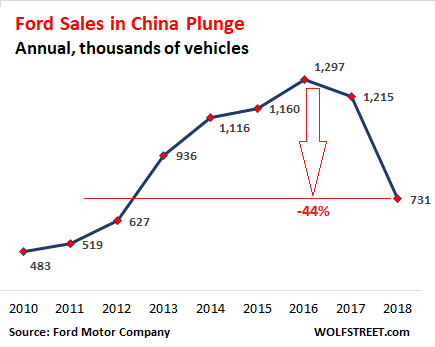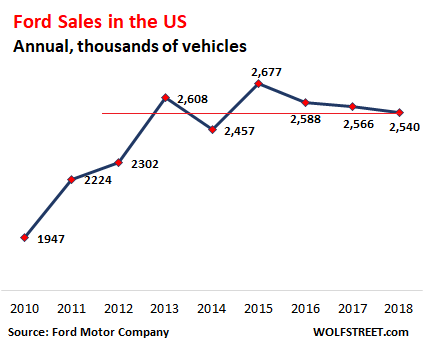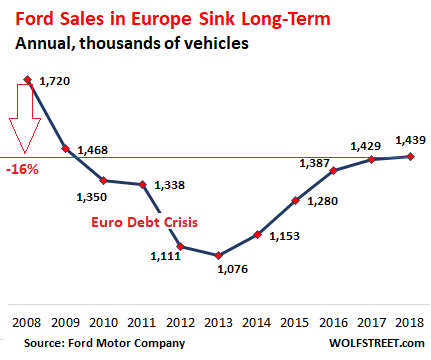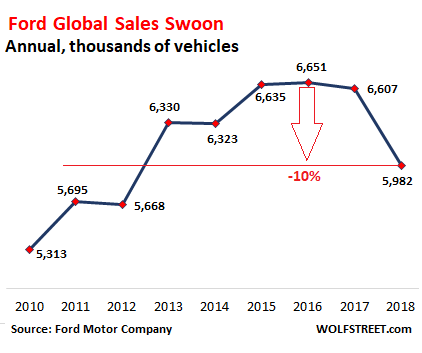Wolf Richter wolfstreet.com, http://www.amazon.com/author/wolfrichter
The New Emissions & Fuel-Economy Cheating Scandal is just a Dimple.
It’s tempting to think that Ford’s Carmageddon is a new “dieselgate” after Ford announced last night that “a handful of employees raised a concern” about its testing procedures for fuel economy and emissions certifications. Sure, Ford might get nailed. It’s furiously trying to make the getting-nailed less painful by announcing a slew of actions and self-reporting this debacle – well, the “potential concerns” – to the EPA and the California Air Resources Board rather than covering it up.
Ford might have to pay fines and face lawsuits. It – along with other automakers – has already been caught red-handed overstating fuel economy. No problem. It got through those debacles. Volkswagen got through dieselgate. Other automakers are going through, or have already settled, their own dieselgates. Corporate malfeasance can be costly. But it blows over.
Declining vehicle sales are harder to fix.
This scandal is just a dimple compared to Ford’s global problem. Its vehicles sales have been on decline in Europe since 2008; they’ve essentially collapsed in China over the past two years; and they fell in the US for the past three years.
In addition to disclosing the testing debacle yesterday evening, Ford also filed its annual report (10-K). It contains audited numbers, including global annual vehicle sales — the number of vehicles that Ford sold to its dealers (that they then sell and “deliver” to their customers).
Ford’s China sales have collapsed
Ford’s annual sales through its joint ventures in China – by far the largest auto market in the world where GM sells more vehicles than in the US – peaked in 2016 at 1.297 million vehicles, according to Ford’s 10-K. But in 2018, Ford sold only 731,000 vehicles. A two-year plunge of 44%.
Across all automakers, the number of vehicles sold in China dipped 4% in 2018, as a solid beginning was wiped out by a sharp decline in the second half. 2017 had been a record year for the auto industry. For Ford, both years were Carmageddon. Its 2018 sales were not that much higher than its sales in 2012:

Ford’s US sales dropped for the third year in a row.
In 2018, Ford sold 2.54 million vehicles in the US, according to its 10-K. It was the third year in a row that sales declined, bringing the total decline to 5% from its peak in 2015. This puts the 2018 sales volume below where it had been in 2013:

CEO Jim Hackett, whom Ford promoted in May 2017 from his Silicon Valley gig at Ford Smart Mobility, is running around the media-and-analysts circuit, pitching his layoffs-and-cost-cuts turnaround plan “Fitness Redesign,” after his predecessor flagellated his arms wildly, pitching his own layoffs-and-cost-cuts turnaround plan before getting sacked. These plans come with many billions of dollars in write-offs.
The idea of Smart Mobility, Hackett’s former gig, is to compete with Uber and Google and whatnot. The unit houses, among other things, self-driving ventures and a jewel called Chariot Transit, an app-based shuttle service Ford acquired in late 2016. At the time, it ran a few vans around San Francisco to shuttle folks between residential areas to tech-job locations. It then expanded to other cities and countries. It competed directly with city buses. A month ago, the high-tech venture was shut down. This kind of stuff sidetracks an automaker.
Ford of Europe’s long-term decline
When the Eurozone went through the Financial Crisis and its subsequent Euro Debt Crisis, Ford’s sales plunged 37% between 2008 and 2013. Then they recovered. In 2018, sales rose to 1.44 million vehicles. Quite a feat for a company whose global sales are swooning. But those 2018 sales were still down 16% from 2008:

Ford’s global vehicle sales dropped 10% in two years
Ford sells vehicles around the world, in North America, South America, Europe, Russia, Turkey, across Asia and the Pacific region, in the Middle East, and Africa. These “Total Company” sales peaked in 2016 and have since dropped 10% to 5.98 million vehicles. This puts sales just above where they’d been in 2012 and 2011:

So just increase the prices.
How does Ford try to keep its dollar sales from taking the same steep route of its unit sales? Jacking up prices. And executives are bragging about it to prop up the swooning shares.
The metric they toss around is the average transaction price – the price at which the vehicle is sold to consumers after haggling. During the earnings call for the fourth quarter, Executive VP James Farley, Jr. bragged about the “double-digit increase in transaction prices last quarter” for the Escape and Focus models; and CEO Hackett bragged about pickup transaction prices being “about $2,000 above segment average.”
Raising prices on declining volume to cover up the decline in volume is not an elegant solution for the long term.
Waiting for Junk.
Last August, Moody’s cut Ford to Baa3 with negative outlook. This is Moody’s lowest investment-grade rating (here’s my color-corded credit-rating scale for the three major US ratings agencies). Moody’s cited the erosion in Ford’s “global business position and the challenges it will face implementing its Fitness Redesign program” that comes with a cost of something like $11 billion.
A downgrade to “junk” would make borrowing costlier and pose a slew of problems for Ford. So it’s trying to keep its margins intact by raising prices and do other things to persuade the ratings agencies to not cut it to junk.
But the real trouble is in Ford’s vehicle sales. That’s the core of its business. The fact that Ford seems to have trouble finding any buyers for its vehicles in China, that in the US, its sales have been falling for three years, and that in Europe the decline has now been going on for over a decade: that’s the real Carmageddon for Ford, not the evolving emissions and fuel-economy cheating scandal, for which it will be slapped on the wrist in the worst-case scenario. But with these kinds of declines in vehicle sales, year after year, good luck.